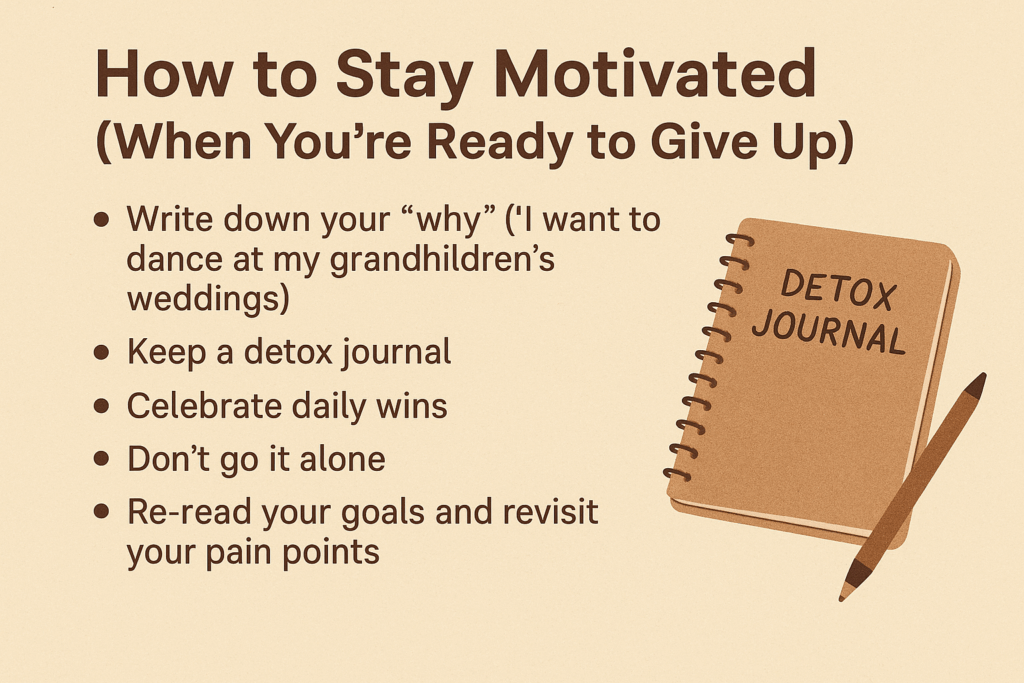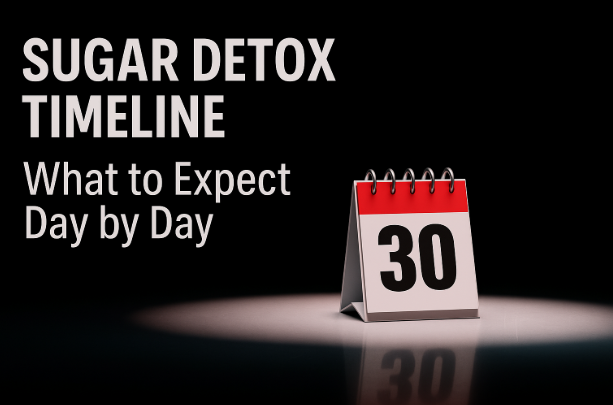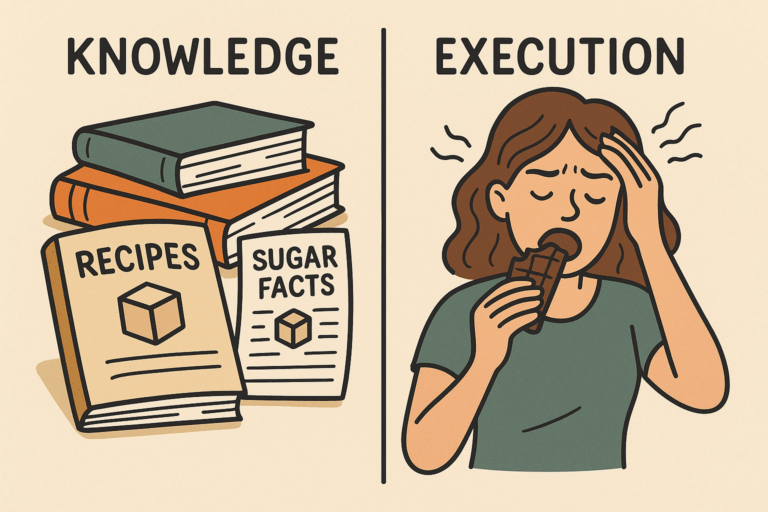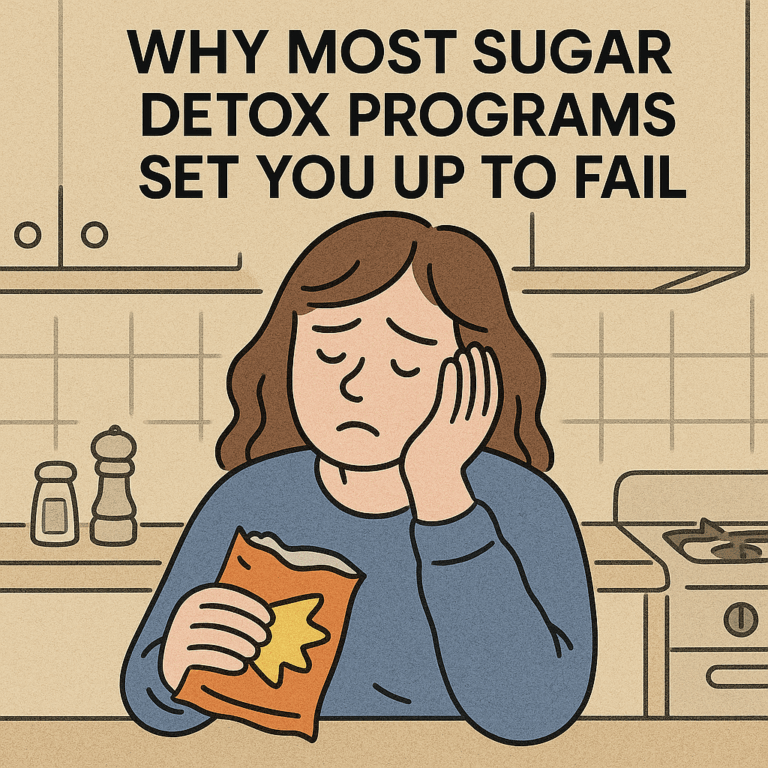By Mike Collins, The SugarFreeMan
Introduction: Why You’re Here (And What’s About to Change)
If you found your way here, chances are you already know sugar has taken more from you than it’s given. Brain fog, mood swings, belly fat, cravings you can’t explain – it doesn’t have to be this way.
Whether you’re just starting out or are looking for a fresh approach, this sugar detox for beginners guide will help you take control and begin the healing process.
I’ve been where you are, and I’ve helped tens of thousands of people like you regain their health, clarity, and confidence.
“It’s not your fault. But it is your time.”
This guide is your roadmap. We’ll walk through the science, the cravings, the mood swings, and, most importantly, the recovery. Because that’s what this is: recovery from an addictive substance wrapped in a thousand disguises.
You are not weak.
You are not broken.
You are waking up to the truth.

Before You Begin: The Mindset Shift That Changes Everything
Before we talk about what to eat and what to avoid, let’s talk about something more important – how you think about this.
A sugar detox is not a punishment.
It’s not a fad.
And it’s not a diet.
It’s a decision to reclaim your health and your power.
This isn’t about “being good.” It’s about getting free.
“You’re not starting a diet. You’re ending a toxic relationship – with sugar, and with self-blame.”
Here’s what I want you to remember going in:
- You will not do this perfectly. That’s OK.
- There will be tough moments. That’s normal.
- Every meal is a chance to come back to your goals.
- This is a short window that leads to a much bigger reward.
Focus on progress, not perfection. Think of this as a reset, a way to learn what life can feel like when you’re not constantly fighting cravings, energy crashes, or food guilt. You’re about to hear your body’s authentic voice again.
“You’re not here to be punished. You’re here to be restored.”
Now let’s get into it.
If you found your way here, you already know sugar has taken more from you than it’s given. Brain fog, mood swings, belly fat, cravings you can’t explain, it doesn’t have to be this way.
I’ve been where you are, and I’ve helped tens of thousands of people like you regain their health, clarity, and confidence.
“It’s not your fault. But it is your time.”
What Is a Sugar Detox and Why You Need One
A sugar detox means removing all added sugars and highly refined carbohydrates from your diet, for a period of time, to let your body and brain reset.
Think of it like clearing static from a radio; suddenly, you can hear your real needs again.
Sugar triggers the same dopamine pathways as alcohol and drugs. You’re not weak. You’re biologically wired to want more. And that wiring gets hijacked. The modern food environment exploits that wiring, and leaves us wondering why we can’t stop at one.
“Sugar hijacks your brain chemistry. You’re not crazy – your natural brain and body reward systems have been hijacked.”
The first step to freedom is understanding that this isn’t just about willpower.
It’s about biology. And biology can be healed.
Once you understand the grip sugar has on your system, you can start to loosen it, step by step, with support and strategy.
The Hidden Sources of Sugar You’re Probably Still Eating

Even when you think you’re being “healthy,” sugar sneaks in. Here are a few culprits:
- Flavored yogurts
- Salad dressings
- Granola bars
- Pasta sauces
- “Healthy” cereals
- Protein shakes
- Canned soups
- Meal replacement drinks
- Frozen meals
“Read the label. Sugar wears a thousand masks.”
Sugar hides behind names like maltodextrin, brown rice syrup, agave, and evaporated cane juice. If it ends in “-ose,” chances are it’s sugar. Learning to identify these hidden sugars is one of your superpowers. Awareness is the first antidote.
Sugar Withdrawal Symptoms: What to Expect (and How to Handle Them)

When you cut out sugar, your body might freak out a little. That’s normal. Symptoms can include:
- Headaches
- Fatigue
- Mood swings
- Anxiety or depression
- Intense cravings
- Trouble sleeping
- Irratability
“Withdrawal isn’t weakness. It’s the sound of your body rebooting.”
Why does this happen? Because your body is recalibrating. Sugar numbed the signals. Now they’re waking up. To ease symptoms:
- Stay hydrated. Drink half your body weight in ounces
- Add electrolytes (salt, magnesium, potassium)
- Eat enough healthy fats and protein
- Go to bed early
- Avoid caffeine or alcohol during detox
These symptoms usually peak in the first 3–5 days. Then they start to fade.
Just hold on.
How to Prepare for a Sugar Detox: Your First 72 Hours
- Clean out your pantry. Toss anything with added sugars or refined grains.
- Stock up on real food: eggs, meats, fish, chicken, avocados, and leafy greens.
- Plan your meals in advance. Avoid decision fatigue when the cravings hit.
- Join a community or find support. Willpower is a myth.
Environment is everything.
“Don’t white-knuckle it. Prepare like a pro and you’ll win like one.”
The first three to five days are usually the hardest, sometimes as long as ten. That’s why our 30-Day Sugar Detox Challenge exists – to guide you through the toughest part and give you the tools to make it stick.
Foods to Eat and Avoid During Your Sugar Detox

Eat more of:
- Protein: eggs, fish, beef, poultry
- Healthy fats: avocado, olive oil, butter, coconut oil
- Low-starch veggies: spinach, broccoli, cauliflower, cabbage, zucchini
- Bone broth, fermented foods
Avoid:
- All added sugars
- Refined grains (white flour, pasta, crackers, baked goods)
- Fruit juices and sweetened drinks
- Artificial sweeteners (they keep cravings alive)
- Processed snack foods, even “low-carb” ones
“Cravings hate protein and fat. Starve the sugar beast, feed your real self.”
Focus on nourishment over deprivation. Eat until you’re full. Rewire your brain to associate real food with satisfaction.
The Emotional Side of Sugar Detox: What Lose Weight Gurus Never Tell You, Or Ever Even Talk About!
This part isn’t talked about enough. Many of us used sugar to numb our feelings. It soothed anxiety, loneliness, boredom. Without it, those emotions surface.
“For some of us, sugar was our first drug. Our first comfort. Our first betrayal.”
When those emotions show up, don’t push them down. This is your chance to heal, not just your body, but your story.
Journal.
Walk.
Talk to someone.
You’re not crazy – you’re waking up.
Let the tears come.
They carry your healing.
How to Stay Motivated (When You’re Ready to Give Up)
- Write down your “why” (“I want to dance at my grandchildren’s weddings”)
- Keep a detox journal
- Celebrate daily wins
- Don’t go it alone
- Re-read your goals and revisit your pain points
“You don’t need perfect. You need progress. One clean meal at a time.”
💡 Looking for a proven path? The 30-Day Sugar Detox Challenge has helped thousands stay the course.
Motivation will fade. But your habits and systems can carry you through.
Build rituals, not rules.

What Happens After the Detox: Building a Sugar-Free Life
After a week or two, your energy starts to rise, your thinking clears, cravings fade, and you begin to feel something you forgot was possible: peace.
Stay consistent. One day at a time becomes one month, one year, a new identity. This is more than just removing sugar – it’s about reclaiming your power, your clarity, your joy.
“Detox is just the beginning. Sugar freedom is a lifestyle.”
And remember, you’re not going back to who you were before sugar. You’re becoming someone new.

Ready for More Support? Joing the 30-Day Sugar Detox Challenge
If you’re serious about ending the cycle, this is your next step.
✅ Daily coaching lessons
✅ Grocery lists and recipes
✅ Recovery tips
✅ Lifetime access for just $9.97
👉 Join the 30-Day Sugar Detox Challenge NOW
“It’s not just a detox. It’s a declaration: I’m done being ruled by sugar.”
The cost is low. The value is high. And your future self will thank you.
Frequently Asked Questions
How long does it take to detox from sugar?
Withdrawal symptoms usually last 3 to 7 days, but if you have a big habit, they can last two weeks. Mental clarity and energy begin to rise in weeks 2–3.
What should I eat during a sugar detox?
Focus on whole foods: meat, eggs, healthy fats, and low-carb veggies.
Can I have fruit while detoxing from sugar?
In the first week, it’s best to avoid sweet fruits. Later, small portions of berries may be okay.
What are the withdrawal symptoms, and how long do they last?
Headaches, fatigue, irritability, and cravings are common. Most symptoms pass in under a week.
Do I need supplements to quit sugar?
You may benefit from magnesium. But whole foods are the foundation.
What’s the difference between a sugar detox and going keto?
Keto is a long-term low-carb lifestyle. A sugar detox is a short-term reset that can lead to keto if desired. Many people call the beginning of the keto diet “The Keto Flu,” but in reality, the keto flu is really sugar withdrawals!
You’re not alone. You’re not broken. And you don’t have to keep living on the sugar rollercoaster. Let this be your beginning.
“You came here searching for a way out. I’m telling you – this is it.”







Alguém aí já fez segurobet saque? Demora muito pra cair na conta? Tô precisando da grana urgente! Me contem como foi a experiência de vocês! ⏳💸
I’m not sure exactly why but this web site is loading incredibly slow
for me. Is anyone else having this problem or is it a issue on my end?
I’ll check back later on and see if the problem still
exists.
Plunge into the massive galaxy of EVE Online. Become a legend today. Explore alongside hundreds of thousands of explorers worldwide. Begin your journey
I like the helpful information you provide in your articles.
I will bookmark your weblog and check again here regularly.
I am quite certain I’ll learn lots of new stuff right here!
Best of luck for the next!
Venture into the vast realm of EVE Online. Find your fleet today. Conquer alongside thousands of pilots worldwide. Download free
Этот обзорный материал предоставляет информационно насыщенные данные, касающиеся актуальных тем. Мы стремимся сделать информацию доступной и структурированной, чтобы читатели могли легко ориентироваться в наших выводах. Познайте новое с нашим обзором!
Ознакомиться с деталями – https://vivod-iz-zapoya-1.ru/
Enjoyed reading through this, very good stuff, thankyou.
Immediate Olux se demarque comme une plateforme de placement crypto innovante, qui exploite la puissance de l’intelligence artificielle pour offrir a ses utilisateurs des avantages concurrentiels decisifs.
Son IA analyse les marches en temps reel, detecte les occasions interessantes et execute des strategies complexes avec une exactitude et une rapidite inatteignables pour les traders humains, optimisant ainsi les potentiels de profit.
Clarte Nexive Review
Clarte Nexive se demarque comme une plateforme de placement crypto innovante, qui utilise la puissance de l’intelligence artificielle pour fournir a ses clients des avantages concurrentiels decisifs.
Son IA analyse les marches en temps reel, identifie les opportunites et applique des tactiques complexes avec une finesse et une celerite hors de portee des traders humains, augmentant de ce fait les potentiels de profit.
TurkPaydexHub se demarque comme une plateforme d’investissement en crypto-monnaies de pointe, qui exploite la puissance de l’intelligence artificielle pour offrir a ses utilisateurs des avantages decisifs sur le marche.
Son IA analyse les marches en temps reel, detecte les occasions interessantes et applique des tactiques complexes avec une finesse et une celerite hors de portee des traders humains, augmentant de ce fait les perspectives de gain.
TurkPaydexHub page officielle
TurkPaydexHub se distingue comme une plateforme d’investissement en crypto-monnaies de pointe, qui exploite la puissance de l’intelligence artificielle pour proposer a ses membres des avantages decisifs sur le marche.
Son IA scrute les marches en temps reel, detecte les occasions interessantes et execute des strategies complexes avec une exactitude et une rapidite inaccessibles aux traders humains, optimisant ainsi les potentiels de profit.
There are some interesting closing dates on this article but I don’t know if I see all of them middle to heart. There may be some validity however I’ll take maintain opinion till I look into it further. Good article , thanks and we wish more! Added to FeedBurner as nicely